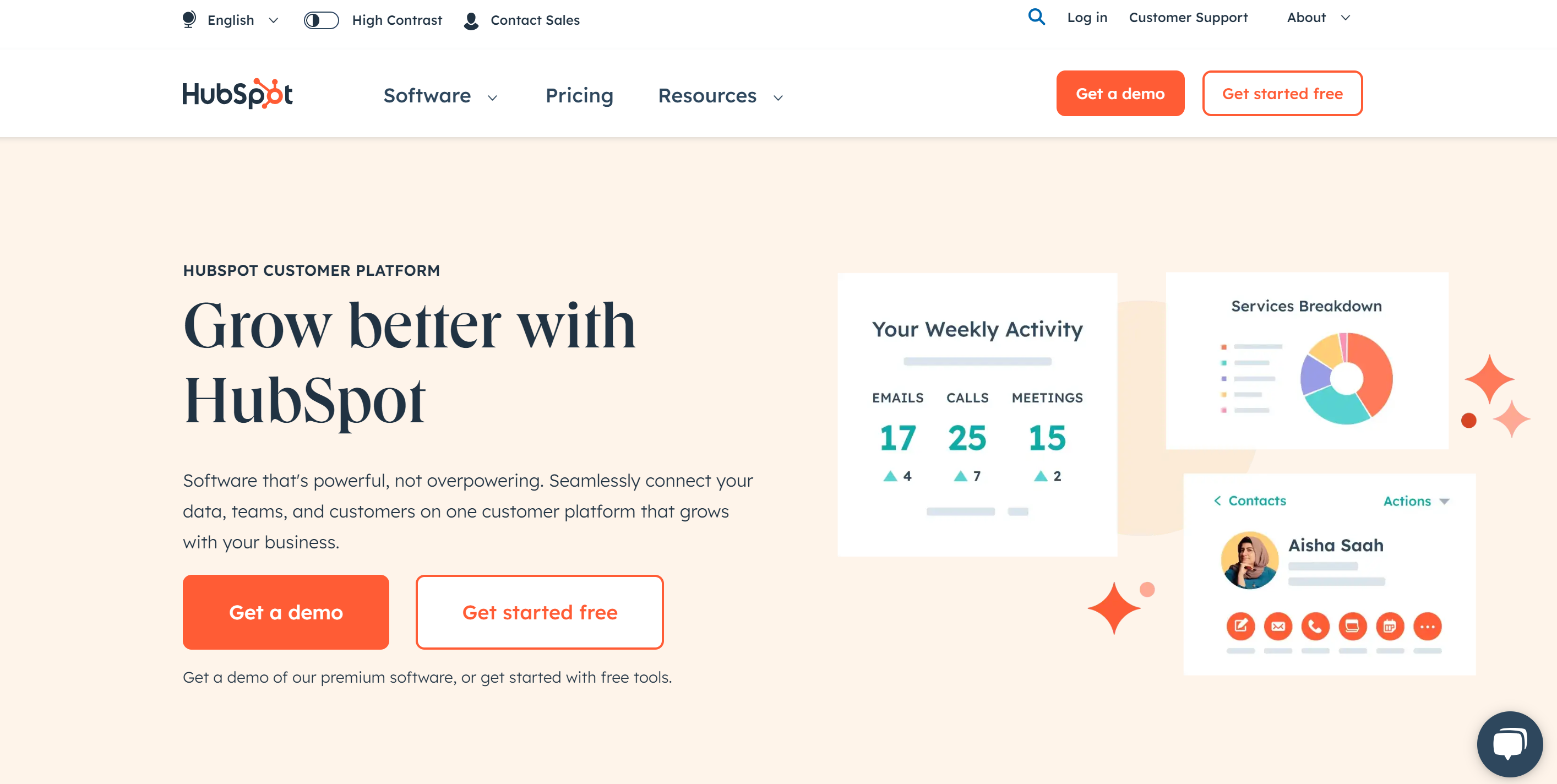Automating the sending of personalized emails based on triggers such as user behavior or time intervals. For example, a customer can fill in a contact form on your website, including their email address. Once the system receives that information, the email automation software can be set up to send a welcome email to the new prospect, giving them some information about the product or service that you sell and even encouraging them to book an appointment with a sales representative if they haven’t already.
Driving Results: Maximizing ROI with Marketing Automation

Sections
Introduction to Marketing Automation
Marketing isn’t easy. It doesn’t matter which industry or company that you do marketing for, it requires thought, effort, and constant optimization based on what you learn over time. But today, there are many different digital platforms essential for marketing that require your near-constant attention: email, social media, SMS, your website…the list goes on.
To complicate matters further, most salespeople know about the 5-minute rule when it comes to contacting leads. It’s not a super hard and fast rule these days, but the point remains that you don’t have a ton of time to reach out to a potential customer. If you miss their message or take too long to reach out, especially with the internet being so competitive, they’ll likely go to a different company that will meet their needs faster. This is regardless of which channel they use to reach out to you.
So how can you keep up with the demand, especially when your organization grows and needs to move more and more customers through your sales pipeline?
The answer is digital marketing automation.
Many companies are already using marketing automation software, whether it’s within their CRMs, email platforms, or social media channels, to keep in touch with their customers regardless of when they reach out. A simple welcome message is often enough to keep the customer engaged until a real person can reach out.
But marketing automation goes much further than that first touch. It’s an essential tool that can be used for a wide range of targeted messaging and engagement with the customer, from that initial reach out to answering questions, providing technical and customer support, and much, much more.
Everyone is a customer. So it’s easy to put yourself in the shoes of one of your customers and imagine what it would be like to deal with your sales process or customer service team. These days, people expect fast, effective service because they know that businesses have the technology and tools available to them to meet those expectations. There’s no reason in a customer’s mind, especially for a business that has a functioning website and social media presence, for it to take a long time for them to find the answers they are looking for, whether it be to help them make a purchase decision or to get support for a product or service they bought through you.
In addition, marketing automation has shifted customer expectations with regard to conversations with organizations they do business with. Make a purchase online? Most people expect to receive a confirmation or welcome email. Start a case with technical support or a customer service agent. An email outlining the details that the customer needs to know, like the case number, should be sent immediately.
The long and short of it is, if your business isn’t taking full advantage of marketing automation and the opportunities allow, then you’re already behind. But with that being said, marketing automation can also be done poorly, which negatively impacts the customer experience instead of helping it.
In this comprehensive article, we explore the ins and outs of marketing automation, including how newer technologies like artificial intelligence (AI) and machine learning (ML) have revolutionized the space.
Discover what Ringy can do to accelerate your business growth by reaching out to us today for a demo.
Book A Demo
What is Marketing Automation?
Marketing automation refers to the use of software platforms and technologies (like the aforementioned AI and ML) to automate repetitive marketing tasks and workflows. Usually, digital marketing automation is built into a Customer Relationship Management (CRM) system, so is often referred to as CRM marketing automation. Task automations typically include:
- Email marketing
- Social media posting
- Ad campaigns
- Lead generation automation
- Lead nurturing automation
- Customer segmentation
With CRM marketing automation, businesses can streamline their marketing processes, improve efficiency, and deliver personalized experiences to their audience at scale. It also allows marketers to automate routine tasks, freeing up time for more strategic activities like analyzing data, refining targeting strategies, and optimizing campaign performance.
In other words, task automation reduces the need to put a ton of manual time and effort into understanding the data that your customers generate every day and instead analyzes that data for you and helps you make smarter decisions on how to reach potential customers and existing customers. In addition, you can ensure that you stay engaged with your customers digitally by sending them timely, relevant, and personalized messages to keep your business at the front of their minds.
What Can Marketing Automation Do For Your Business?

As the intro of this article alluded to, the common challenges faced by businesses include generating leads and keeping them engaged throughout their purchasing journey. If customers feel neglected at any point, they’ll likely say, “See you later!” and move on to a different business that offers a similar service.
In addition to these challenges, many businesses struggle to leverage the vast amount of data that they collect on a daily basis regarding their prospects and customers—how can it be harnessed to drive growth and favorable outcomes?
Marketing automation is a crucial piece of the puzzle for overcoming these challenges. It can be thoughtfully integrated into your entire sales process through personalized workflows and streamlined processes.
Personalized Workflows
In marketing automation, personalized workflows involve the creation of tailored, dynamic pathways for individual leads and customers based on their behavior, preferences, and interactions with your brand. These workflows enable businesses to deliver relevant content and experiences to each lead and customer, ultimately driving engagement, nurturing them, and increasing conversions.
In other words, personalized workflows help you understand what your customers want. Of course, it would be nearly impossible to track each customer's behavior manually, especially if you have hundreds or thousands of customers moving through your sales process. With marketing automation software, however, businesses can track these inputs across multiple different channels and use the data gleaned to determine when, where, and how to engage with customers across their entire sales pipeline without being too pushy or salesy.
Streamlined processes
Marketing automation leads to streamlined processes by automating repetitive tasks, improving efficiency, and facilitating better coordination among marketing teams. The table below outlines how:
| Key Task that Marketing Automation Software Streamlines | How it Works |
Automating repetitive tasks |
Marketing automation platforms allow businesses to automate repetitive tasks such as sending emails through CRM email integration, posting on social media, and managing leads. Through task automation software powered by marketing automation, businesses can save time and resources that would otherwise be spent on manual labor. For example, instead of manually sending out individual emails to each lead, marketers can create automated email campaigns that are triggered by specific actions or events, such as signing up for a newsletter or downloading a whitepaper. |
Centralizing data and workflows |
Marketing automation platforms often integrate seamlessly with customer relationship management (CRM) systems, allowing businesses to centralize customer data and optimize workflows. This integration enables effective data sharing between marketing, sales, and other departments, reducing duplication of effort and ensuring consistency across teams. For example, when a lead fills out a form on a website, their information is automatically captured in the CRM system and can be used to trigger automated follow-up emails or assign tasks to sales reps. |
Improving communication and collaboration |
Marketing automation facilitates better communication and collaboration among team members by providing a centralized platform for managing campaigns, tracking progress, and sharing insights. Team members can collaborate more effectively on campaign planning, content creation, and strategy development, leading to more cohesive and coordinated marketing efforts. For example, marketing automation platforms often include features such as shared calendars, task assignments, and integration with real-time collaboration tools (think Zoom and Slack) that enable team members to work together more efficiently. |
Enhancing lead management |
Lead management automation processes enable automatic lead scoring, segmentation, and nurturing. Instead of manually sorting through leads and determining their level of interest, marketers can use automated lead-scoring algorithms to prioritize leads based on their behavior and engagement level. Automated lead nurturing workflows can then deliver targeted content to leads at each stage of the buyer's journey, guiding them through the funnel and increasing the likelihood of conversion. |
It’s important to take careful consideration for how marketing automation fits appropriately within your business’s sales and customer service processes to ensure that you’re not pushing customers down a sales or customer service path that doesn’t feel natural. For example, making a customer complete unnecessary steps, like filling out their information over and over again every time they deal with a new customer service agent, will just annoy them. Instead, take advantage of automation by connecting your marketing automation system to your CRM, allowing any rep to access centralized information about the customer in question and see past conversation history and other relevant information without having to request it from the customer.
The point is to balance the digital with the human element but allow marketing automation to enhance your customer experience instead of hindering it.
Key Components of Marketing Automation

The key components of an effective marketing automation strategy include the following initiatives:
Email marketing automation software:
Lead management and nurturing:
Lead Automation
is the process of capturing leads, segmenting them based on demographics or behavior, and nurturing them with targeted content to move them through the sales funnel.
Free trial of your software
For example, a prospect that is a week into their free trial of your software could be sent some content on utilizing the software in the most effective way. You can even send relevant, targeted content that makes sense to the prospect’s industry and business type.
Campaign management:
Managing multi-channel marketing campaigns, including tracking and analyzing performance metrics in real-time, gives actionable insights without having to manually crunch numbers. This allows you to make effective, educated business decisions on which marketing campaigns to pursue in the future and what adjustments are necessary.
Customer relationship management (CRM) integration:
Integrating marketing automation platforms with CRM systems to ensure seamless data flow between marketing and sales teams and enable personalized communication with customers.
Customer segmentation:
Marketing automation allows businesses to segment their audience based on various criteria such as demographics, behavior, purchase history, and engagement level. By dividing their audience into smaller, more targeted segments, marketers can deliver personalized and relevant content to each group. For example, a clothing retailer might segment their customers based on gender, age, location, or past purchase history and then tailor their marketing messages and offers accordingly. Marketing automation platforms typically offer tools to create and manage these segments and automate the delivery of targeted campaigns to each segment.
Time-based messaging:
Refers to the ability to send automated messages or campaigns to contacts at specific times or intervals. Marketing automation platforms enable marketers to schedule emails, social media posts, SMS, and other communications to be sent at optimal times when they are most likely to be seen and engaged with by the target audience. For example, an e-commerce business might schedule a promotional email to be sent to subscribers on their birthday, or a software company might send a series of onboarding emails to new users at predetermined intervals after they sign up. By automating time-based messaging, businesses can ensure consistent communication with their audience without the need for manual intervention.
Analytics and reporting:
Marketing automation platforms provide robust analytics and reporting tools that allow marketers to track and measure the performance of their campaigns in real-time. These tools enable marketers to monitor key metrics such as open rates, click-through rates, conversion rates, and ROI, as well as to gain insights into customer behavior and preferences. By analyzing this data, marketers can identify trends, patterns, and opportunities for optimization, allowing them to refine their strategies and improve their results over time. Additionally, many marketing automation platforms offer customizable dashboards and reports that allow marketers to visualize their data in meaningful ways and share insights with stakeholders across the organization. Overall, analytics and reporting are essential components of marketing automation that empower businesses to make data-driven decisions and achieve their marketing objectives more effectively.
Examples of Marketing Automation

From email campaigns to social media management, advertising, and beyond, various marketing automation solutions are available to suit different needs and objectives. Let’s explore some of the key marketing automation examples and how they can benefit businesses.
1. Drip Campaigns (Email and SMS)
Drip campaigns are a type of automated marketing campaign that involves sending a series of pre-written messages to prospects or customers over a period of time. These messages are typically personalized and timed strategically to nurture leads, onboard new customers, or re-engage inactive users. With email drip campaigns, marketers can set up triggers based on user actions or behaviors, such as signing up for a newsletter, abandoning a cart, or completing a purchase. Similarly, SMS drip campaigns can be used to deliver timely messages and promotions directly to customers' mobile devices. Businesses can maintain consistent communication with their audience, deliver relevant content, and drive conversions by automating drip campaigns.
With Ringy, it’s easy to create and execute drip campaigns. Simply navigate to the campaign tab choose the relevant lead list, and then filter through them using different tags and terms as needed. Once you have your list, you can bulk email these leads with a singular message.
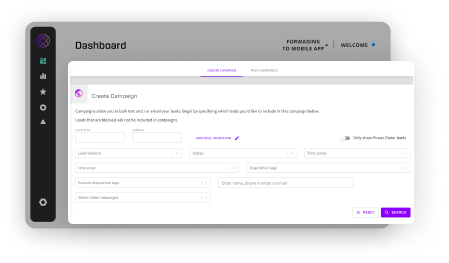
You can also navigate to the marketing tab and choose email or SMS to create tailored automated responses based on your customers' or prospects' behaviors or other triggers.
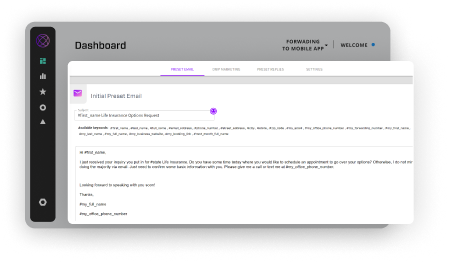
2. CRM Automation
A CRM and marketing automation are two different things, but they often go together in one system (the CRM itself).
- A CRM is a platform that stores knowledge about your prospects and customers (contact details, previous interactions, purchase history, etc.), helping sales reps manage their leads and customers.
A marketing automation system allows marketers and sales teams to automate activities such as emails, social media posts, notifications, reminders, and SMS.
CRM automation involves automating various aspects of the customer relationship management process, such as data entry, lead scoring, and task assignment. By integrating marketing automation platforms with CRM systems, businesses can streamline workflows, track interactions with prospects and customers, and provide personalized experiences at every touchpoint. CRM automation allows marketers to prioritize leads based on their likelihood to convert, track engagement across channels, and deliver targeted messages based on customer preferences and behavior.
For example, with Ringy, you can easily view your sales pipeline and organize your leads based on whatever priorities or criteria are important to your team or company. From there, you can determine how to reach out to prospects and move them through your pipeline.
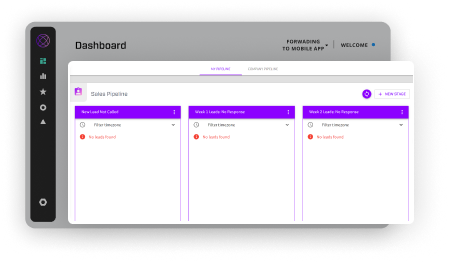
3. Social Media Marketing Automation
Social media marketing automation tools enable businesses to manage and automate their social media activities, including content scheduling, posting, monitoring, and engagement. These tools allow marketers to schedule posts in advance, monitor conversations and mentions, and analyze performance metrics across multiple social media platforms. By automating repetitive tasks, businesses can save time, maintain a consistent presence on social media, and engage with their audience more effectively. Social media marketing automation also enables marketers to identify trends, track brand sentiment, and measure the impact of their social media efforts.
4. Advertising Automation
Advertising automation involves automating the process of planning, buying, and optimizing digital advertising campaigns across various channels, such as search engines, social media platforms, and display networks. With AI process automation tools, marketers can set campaign objectives, target specific audiences, and allocate budgets based on performance metrics and ROI goals. These tools often leverage machine learning algorithms to optimize ad placements, bidding strategies, and creative assets in real-time, maximizing the effectiveness of advertising spending and driving results.
5. Lead Automation
Lead automation is a crucial aspect of marketing automation that focuses on streamlining the
process of capturing, nurturing, and converting leads. It involves using automated workflows, personalized messaging, and data-driven strategies to engage with leads effectively and move them through the sales funnel.
How Marketing Automation Empowers Different Industries
Marketing automation empowers different industries by providing tools and strategies tailored to their unique needs and objectives. Here's how marketing automation benefits various sectors:
Insurance
One of the biggest challenges for most insurers is that they often sell and promote various services to a wide audience. Being able to communicate with existing policyholders and attract new customers at the same time can be difficult, especially when you consider all the different people that they need to market to new couples, seniors, individuals, small businesses, corporations, enterprise organizations…the list is endless. Marketing automation systems can provide the outreach, communication, and data insurers need to keep track of it all.
- Lead generation: Marketing automation helps insurance companies generate and nurture leads through targeted campaigns tailored to specific demographics, life events, or insurance needs.
- Personalized communication: Automation allows insurers to deliver personalized messages and offers to prospects and policyholders based on their interests, preferences, and policy status.
- Cross-selling and upselling: Automation enables insurers to identify cross-selling and upselling opportunities by analyzing customer data and delivering targeted promotions or recommendations. For example, a customer purchasing home insurance may also be interested in auto insurance.
- Renewal reminders: Automated reminders and notifications help insurance companies stay in touch with customers and remind them to renew their policies, reducing churn and increasing retention rates.
Finance
Before an individual or a business reaches out to a bank or credit union, they’re doing a ton of research. This means that financial institutions can leverage marketing automation to connect with potential customers through channels such as social media, organic search, and advertising. However, one of the biggest hurdles for financial institutions is developing trust with their customers (after all, these organizations are handling people’s money). Through marketing automation, these institutions can easily handle that first touch when the customer reaches out and leverage automation to keep the relationship going throughout the sales process and after.
- Lead generation and nurturing: Marketing automation helps financial institutions attract and engage prospects through targeted campaigns that address their financial needs and goals.
- Relationship building: Automation allows banks and financial advisors to build and maintain relationships with clients by delivering personalized content, educational resources, and timely updates.
- Compliance and regulation: Marketing automation platforms often include features to ensure compliance with regulatory requirements, such as tracking opt-ins, managing consent, and maintaining audit trails.
- Cross-selling and upselling: Automation helps financial institutions identify cross-selling and upselling opportunities by analyzing customer data and delivering targeted offers based on their financial behaviors and preferences.
SaaS (Software as a Service)
With SaaS companies, pretty much everything is digital. The way that prospects find the organization, sign up, and receive onboarding and help is all done online. But behind the scenes, customer service and sales reps have to work hard to keep customers happy. With marketing automation, SaaS companies can provide some self-service options so that customers can get fast answers to their questions without having to wait for a response from a real person, and customers can be kept informed about everything to do with the software (including updates and outages) within a moment’s notice.
- Onboarding and activation: Marketing automation assists SaaS companies in guiding users through the onboarding process and driving product activation by delivering personalized tutorials, welcome emails, and tips.
- Product updates and announcements on new features: Automation enables SaaS companies to keep users informed about new features, updates, and announcements through targeted email campaigns and in-app notifications.
- User engagement and retention: Automation helps SaaS companies engage and retain users by delivering relevant content, educational resources, and offers based on their usage patterns, preferences, and feedback.
- Trial conversion and upselling: Marketing automation supports SaaS companies in converting trial users into paying customers and upselling existing customers by delivering targeted promotions and upgrade offers at key touchpoints in the customer journey.
Customer Service

One of the best ways that you can enhance your customers’ experience is through conversations. Marketing automation helps organizations large and small listen to their customers, provide additional support without making customers wait, and give customers the ability to provide feedback.
- Automated support: Marketing automation can assist customer service teams by providing automated responses to common inquiries, routing tickets to the appropriate department, and escalating urgent issues to human agents.
- Proactive outreach: Automation allows companies to proactively reach out to customers with personalized messages, offers, and surveys to gather feedback, address concerns, and prevent churn.
- Follow-up and feedback: Automated follow-up emails and surveys help companies gather feedback from customers after interactions with customer service representatives, enabling them to measure satisfaction and identify areas for improvement.
- Self-service options: Marketing automation platforms often include self-service options such as knowledge bases, FAQs, and chatbots that empower customers to find answers to their questions and solve problems on their own.
Small Business
With most small businesses, keeping things within a strict budget is important. Marketing automation allows small businesses to control their spending on marketing while at the same time providing benefits like faster and more personalized communication with their customers without the extra effort.
- Cost-effective marketing: Marketing automation for small businesses enables these organizations to automate repetitive marketing tasks, such as email campaigns, social media posting, and lead nurturing, saving time and resources.
- Lead generation and conversion: Automation helps small businesses attract and convert leads by delivering targeted content, offers, and promotions based on customer preferences and behavior.
- Personalized communication: AI Automation tools allow small businesses to deliver personalized customer messages and offers, enhancing engagement and building stronger relationships.
- Data-driven decision-making: Marketing automation provides small businesses with insights into customer behavior, preferences, and campaign performance, enabling them to make data-driven decisions and optimize their marketing strategies for better results.
Benefits of Marketing Automation
Marketing automation has become a game-changer for businesses seeking to streamline their marketing efforts, engage with customers more effectively, and drive growth. By leveraging automation technology, businesses can enhance efficiency, improve customer relationships, and boost their bottom line. Let's explore the key advantages of marketing automation:
1. Streamlines and Simplifies Workflows
By using AI process automation to automate repetitive tasks and processes, businesses can streamline their marketing workflows. Instead of manually executing each marketing activity, such as sending emails, posting on social media, or segmenting leads, automation tools handle these tasks automatically. This streamlining of workflows frees up valuable time and resources for marketing teams to focus on high-value activities like strategy development, content creation, and campaign optimization.
2. Enhances Lead Management and Nurturing
Businesses can manage and nurture leads more effectively throughout the buyer's journey with sales lead automation. These lead automation tools enable lead scoring, lead segmentation, and personalized lead nurturing based on prospect behavior and engagement level. By delivering targeted content and messaging to leads at each stage of the funnel, businesses can increase the likelihood of conversion and accelerate the sales process.
3. Improves Customer Engagement and Retention

One of the primary benefits of marketing automation is its ability to improve customer engagement and retention. Automation allows businesses to deliver personalized and timely communication to customers, keeping them engaged with relevant content, offers, and updates. By nurturing customer relationships through automated campaigns and follow-up sequences, businesses can strengthen loyalty, increase repeat purchases, and reduce churn.
4. Increases Operational Efficiency and Cost Savings
Marketing automation drives operational efficiency and cost savings by reducing manual effort and optimizing resource allocation. By automating repetitive tasks, businesses can accomplish more with fewer resources, saving time and labor costs. Additionally, automation allows businesses to optimize marketing spend by targeting the right audience with the right message at the right time, maximizing ROI, and minimizing wasted resources.
5. Enables Data-Driven Decision Making
With marketing automation, you can gain valuable insights into customer behavior, preferences, and campaign performance through data analytics and reporting tools. By analyzing this data, businesses can make informed decisions about their marketing strategies, identify trends, and optimize their campaigns for better results. Data-driven decision-making enables businesses to continually refine and improve their marketing efforts based on real-time feedback and insights.
6. Allows you to Scale Marketing Efforts
One of the key advantages of marketing automation is its scalability. As businesses grow and expand their marketing efforts, automation tools can scale alongside them, handling larger volumes of leads, customers, and campaigns without requiring additional resources. Automation enables businesses to reach new audiences, enter new markets, and expand their reach more efficiently and effectively.
7. Strengthens Alignment Between Marketing and Sales
Marketing automation fosters closer alignment between marketing and sales teams by facilitating seamless communication and collaboration. Integration between marketing automation platforms and customer relationship management (CRM) systems ensures that leads are passed seamlessly from marketing to sales, enabling more effective lead management and conversion processes. By aligning marketing and sales efforts, businesses can drive better outcomes and achieve greater success.
Skyrocket your sales with the CRM that does it all.
Try Ringy for Free
Actionable Examples of Marketing Automation
It’s important to remember that marketing automation can be used at any stage of your sales process to engage with prospects or customers. You can be creative and come up with different ways to keep your business front of mind without feeling like you’re bombarding your customers with constant communications.
Here are some examples of email workflow automation that you can implement immediately or use as inspiration for creating your own processes:
Welcome Emails
Sending a welcome email via email workflow automation to a new customer or prospect is a common practice with B2B and B2C organizations. Even if the customer has just signed up for a free trial but hasn’t purchased anything, for example, it’s still a good idea to send them an email to welcome them and offer some additional information or insight into whatever product or service you offer. For example, if you sell insurance and the customer reaches out for a quote on auto insurance, a welcome email could simply let them know that someone will reach out with a quote ASAP and give them some additional resources to check out in the meantime, like an auto insurance calculator to give them an estimate while they wait.
Referrals
Asking your satisfied customers for referrals is a great way to attract new customers. Usually, organizations offer customers who provide successful referrals some kind of discount or special offer. You might have a referral program outlined on your website for your customers to take advantage of. Still, it’s always a good idea to send them an email reminding them of the program, especially if they’ve expressed that they’re happy with your product or service.
Some scenarios that you could use to set up an email workflow automation for sending a referral email to customers include:
- The customer leaves a positive review on your website or a review website
- Purchases a product or service
- Has bought from your X number of times
- Has downloaded whitepapers or gated content
- Has signed up for your newsletter
Sales and Discounts
You can easily set up an email automation workflow that promotes any sales or discounts that you have on your leads or existing customer base. If you segment your email list based on your customer’s preferences, purchase history, or engagement level, you can deliver better-targeted offers to those customers. Focusing on using dynamic email content further personalizes these messages even when they are sent to a wide range of people.
Follow-Ups
Automated follow-up emails are a great way to nurture leads who have shown interest in your products or services. Drip campaigns can be used to deliver a series of follow-up emails over time as your lead moves through your sales process. Great times to send follow-up emails include when a lead downloads a piece of content, attends a webinar or is halfway through their free trial of your software.
Lead Engagement

Businesses can use marketing automation to implement automated lead scoring to help organize incoming leads. Scores can be based on things like behavior, engagement level, industry, profession, and more. Automated workflows can also assist with segmenting leads based on their score so that relevant, targeted content that aligns with their interests and needs can be delivered to them. Marketing automation can also be used to track lead interactions across different channels (social media, website, email) and trigger personalized responses based on specific actions or milestones.
Abandoned Baskets and Retargeting
When a customer abandons their cart or leaves the conversion process, you can use an email automation tool to send them a reminder to continue the checkout process. You can even include a special promotional offer, discount, or other incentive to convince them to bite the bullet. In addition, you can use marketing automation to implement retargeting ads on social media or other platforms to re-engage customers who have visited your website but didn't make a purchase, showing them relevant products or offers based on their browsing history.
The below table is a summary of the different examples of marketing automation described above:
| Marketing Automation Example | Description |
Welcome emails |
A welcome email takes care of that first touchpoint and can provide customers with additional information and resources while they wait for a salesperson to contact them. |
Referrals |
If a customer has demonstrated that they like your service in some way, then that’s a great time to give them the option to refer someone else. Generally, referral programs offer the referrer and the receiver a discount, special offer, or other promotion. Many B2B marketers swear on referral programs, saying they bring them many high-quality leads. |
Sales and discounts |
Offering sales or discounts to your loyal customers is a great way to let them know you appreciate their business. Email automation and segmentation are a great way to send targeted offers to the right customers at the right time |
Follow-ups |
Have leads that have shown interest in your product or service but haven’t reached out? Automated emails are a great way to gently follow up with a lead just in case they forgot about you. |
Lead engagement |
Automation can be used to segment and score leads, perform automated reach out, and track interactions across different channels. |
Abandoned baskets and retargeting |
Did a customer leave before checking out? Email automation can be used to gently nudge that customer through your conversion process by reminding them of what they left, either by simply linking to their cart or offering them a small discount to get them to complete the process. |
AI Marketing Automation: An Overview
AI (Artificial Intelligence) marketing automation refers to the use of artificial intelligence and machine learning algorithms to automate and optimize marketing processes and campaigns. So far, we’ve talked about how marketing automation can follow simple triggers or rules that allow you to send out an automated message based on a customer or prospect’s behavior or action.
But AI and ML can take these simple interactions further, enabling you to handle more complex customer demands and situations. For example, an AI-powered chatbot can handle more complex customer questions by being able to read their responses and determine whether the software can send the customer an existing resource to answer their question or get them in contact with a customer service agent. This concept can translate to SMS or email as well, enabling near-instant responses to move customers through the sales process or provide them with support without them having to wait.
How Does AI Marketing Automation Work?
AI marketing platforms work by leveraging artificial intelligence and machine learning algorithms to analyze data, make predictions, and automate marketing processes. The table below outlines how it works in more detail:
| Component of AI Marketing Automation | What it Does |
Data collection and integration |
AI marketing automation |
Data analysis and insights |
AI algorithms analyze the collected data to identify patterns, trends, and correlations that human marketers may not detect. This analysis provides valuable insights into customer behavior, preferences, and purchase intent, allowing marketers to make data-driven decisions and optimize their campaigns for better results. |
Personalization and segmentation |
AI marketing platforms use customer data to segment audiences based on factors such as demographics, behavior, interests, and purchase history. Machine learning algorithms create highly targeted segments and predict which messages and offers are most likely to resonate with each segment. |
Predictive analytics |
AI algorithms use predictive analytics to forecast future trends, behaviors, and outcomes based on historical data. Predictive models analyze past campaign performance, customer interactions, and market trends to predict which marketing strategies are most likely to succeed in the future. |
Automated campaign optimization |
AI marketing automation automates campaign optimization by continuously monitoring and adjusting campaign performance in real time. Machine learning algorithms analyze campaign data, identify areas for improvement, and automatically adjust targeting, messaging, and bidding strategies to maximize results. |
Natural Language Processing (NLP) |
AI marketing automation platforms use natural language processing (NLP) to analyze and interpret unstructured data from sources such as customer reviews, social media comments, and customer service interactions. NLP algorithms extract insights, sentiments, and trends from text data, allowing marketers to understand customer sentiment, identify emerging issues, and respond proactively to customer feedback. |
Chatbots and virtual assistants |
AI marketing automation includes chatbots and virtual assistants that use natural language processing and machine learning to interact with customers in real time. Chatbots can answer customer inquiries, provide product recommendations, and assist with transactions, reducing the need for human intervention and providing a seamless customer experience. |
Why Do You Need AI Marketing Software?
Businesses using AI marketing software have several benefits that relate to efficiency and productivity, including being able to glean insights from vast amounts of data much faster, measuring performance better, and much more.
Here are some benefits of using AI marketing software:
Better decision making:
With advanced AI tools at their disposal, marketing teams can more effectively gauge the impact of their strategies and adapt their approach in nearly real-time. AI-driven platforms leverage machine learning algorithms to formulate strategies and analyze data with unparalleled speed, offering recommendations based on sentiment analysis gleaned from historical customer data.
Increased ROI on marketing investments:
AI marketing tools empower marketers to swiftly extract actionable insights from campaign data as it unfolds. These tools also aid in pinpointing the most effective channels for media placement and optimal ad positioning, all based on customer behavior. By harnessing modern AI marketing solutions, stakeholders can ensure maximum returns on their campaign investments.
Precise KPI measurement:
The abundance of data generated by digital campaigns often overwhelms the human capacity for analysis, making it challenging to gauge marketing success. AI-powered dashboards streamline this process by allowing marketers to directly correlate their efforts with specific tactics deployed, offering clarity on what strategies are effective and areas for improvement.
Streamlined customer relationship management:
AI technologies streamline CRM initiatives by automating routine tasks such as data preparation. By reducing the risk of human error, these tools facilitate the delivery of personalized customer messages and enable the early identification of potentially at-risk customers.
Deeper insights from customer data:
Marketers frequently grapple with being able to glean insights from the vast volumes of data during campaign planning. AI steps in by conducting predictive analytics on customer data, and swiftly analyzing massive datasets using efficient machine learning algorithms. This approach generates insights into future customer behavior, recommends personalized content, and uncovers patterns within extensive datasets for actionable marketing strategies
Best Practices When Implementing Marketing Automation and AI
When you’re implementing AI marketing tools for the first time, it can seem daunting as there is a lot of factors to consider to get it right. You’ll likely have to optimize over time, but to get started, here are some key considerations to keep in mind:
1. Understand Your Customer’s Buying Journey
Successful marketing begins with a deep understanding of your target audience and their purchasing behaviors. Mapping out your customer's buying journey allows you to identify touchpoints where AI automation can effectively engage and influence them. By analyzing data from various channels, such as social media, email, and website interactions, you can tailor your marketing efforts to meet customers' needs at each stage of their journey.
To do this effectively, you could start by creating or referring to a flowchart that outlines your typical sales process. From there, you can use data from your sales pipeline to determine where roadblocks and bottlenecks exist that could be solved with AI process automation. For example, let’s say that you sell a SaaS solution for inventory management, but customers often get stuck on the setup process while they wait for onboarding. You could use AI process automation to provide an in-app pop-up that recognizes when customers seem to be clicking around aimlessly and offers them tips, tricks, and suggestions to move them forward.
2. Segment Your Customers
Not all customers are the same, so treating them as such can lead to missed opportunities. Utilize AI algorithms to segment your audience based on demographics, behaviors, preferences, and purchase history. This segmentation enables you to deliver personalized content and offers, increasing relevance and engagement. AI-powered tools can efficiently handle large datasets, identifying patterns and segments that human analysis might overlook.
3. Develop Engaging Content with AI Writing Tools
Compelling content is the cornerstone of effective marketing campaigns. AI-powered writing tools can assist marketers in generating high-quality content at scale. These tools utilize natural language processing (NLP) algorithms to create engaging copy, whether it's blog posts, social media captions, or email newsletters. By harnessing AI, marketers can save time and resources while maintaining consistency and relevance across their content.
With Ringy’s AI Tools, it’s easy to craft killer content that resonates with your customers. Just enter in a basic concept, like a draft for a welcome email, and let the software give you recommendations and suggestions for tightening your text and giving it that extra edge. You can even save suggested replies for future use, so you don’t have to rewrite responses every time.
4. Create Behavior-based Triggers
Behavior-based triggers enable marketers to respond to customer actions in real-time, delivering personalized experiences that drive conversions. AI algorithms can analyze customer behavior across multiple channels and trigger automated responses based on predefined rules. Whether it's sending a follow-up email after a website visit or offering a discount on a product of interest, behavior-based triggers allow marketers to engage with customers at the right moment with the right message.
5. Embrace A/B Testing

Optimizing marketing campaigns requires continuous experimentation and refinement. A/B testing, also known as split testing, involves comparing two versions of a marketing asset to determine which performs better. AI automation can streamline the A/B testing process by rapidly analyzing data and identifying winning variations. Marketers can iteratively improve campaign performance and drive better results by testing elements such as headlines, images, or call-to-action buttons.
6. Use Data to Continuously Improve
Data is the lifeblood of AI marketing automation. Marketers must continually gather, analyze, and act upon data insights to refine their strategies and achieve better outcomes. AI algorithms excel at processing vast amounts of data to uncover patterns, trends, and opportunities. By leveraging data-driven insights, marketers can optimize targeting, messaging, and campaign performance, ultimately driving higher ROI and customer satisfaction.
The table below summarizes the above points for quick reference:
| AI-based Marketing Optimization Best Practices | Description |
Understand your customer’s buying journey |
Understanding your customers' purchasing path enables you to pinpoint moments where AI automation can actively engage and sway them. By analyzing data sourced from channels like social media, email, and website interactions, you can customize your marketing endeavors to address customers' requirements at every phase of their journey. |
Segment your customers |
Utilizing AI algorithms allows for the automatic segmentation of your audience, considering demographics, behaviors, preferences, and purchase history, all without the need for manual intervention. Segmentation empowers you to provide tailored content and promotions, enhancing relevance and engagement across a broad spectrum. |
Develop engaging content with AI writing tools |
At the heart of successful marketing campaigns lies compelling content. Marketers can leverage AI-powered writing tools to produce top-notch content efficiently and on a large scale. These tools rely on NLP algorithms to craft captivating copy for blog articles, emails, SMS, and more. |
Create behavior-based triggers |
Behavior-based triggers empower marketers to react to customer actions instantly, offering personalized experiences that drive conversions. Through AI algorithms, customer behavior across numerous channels undergoes analysis, enabling the automated triggering of responses according to predetermined criteria. |
Embrace A/B testing |
A/B testing, or split testing, means comparing two versions of a marketing asset to determine which performs better. With AI automation, the A/B testing procedure is expedited as it swiftly analyzes data, quickly pinpointing the winning variations. |
Use data to continuously improve |
Continual data gathering, analysis, and action are important for marketers to refine their strategies over time. AI algorithms shine in processing extensive data sets to unveil patterns, trends, and opportunities. By harnessing data-driven insights, marketers can fine-tune targeting, messaging, and campaign efficacy, resulting in better ROI and higher customer satisfaction. |
Discover what Ringy can do to accelerate your business growth by reaching out to us today for a demo.
Book A Demo
5 Steps to Implement AI in Marketing Automation
The use of use of ai in marketing automation is no longer a luxury but a necessity. AI offers marketers unprecedented capabilities to streamline processes, personalize experiences, and drive better results. However, implementing AI in marketing automation requires a systematic approach.
1. Identify Your Needs and Goals
Before diving into AI marketing automation tools implementation, it's crucial to assess your organization's specific needs and objectives. Define clear goals that you aim to achieve through AI automation, whether it's improving lead generation, enhancing customer engagement, or increasing sales conversions. Conduct a thorough analysis of your current marketing processes, identifying pain points and areas where AI can add the most value.
For example, implementing a chatbot on your website can help quickly answer customer questions on demand. This takes the pressure off of your customer service team and allows customers to move through your sales process quickly.
2. Choose AI Marketing Tools
Once you've identified your goals, research and select the AI marketing tools that best align with your objectives and budget. A wide range of AI-powered solutions are available, including predictive analytics platforms, personalized recommendation engines, chatbots, and content generation tools. Consider factors such as ease of integration, scalability, and the level of customization offered by each tool. Choose reputable vendors with a track record of delivering reliable AI solutions.
3. Setup and Integrate AI Marketing Automation in Your CRM
Integrating AI marketing automation with your CRM system is essential for seamless operation and data synchronization. Ensure that your chosen AI tools are compatible with your existing CRM platform or invest in a CRM solution that offers built-in AI capabilities. Configure the integration settings to enable data exchange between your CRM and AI marketing tools, allowing for personalized customer interactions and streamlined workflows.
4. Use AI to Automate Tasks
With the groundwork laid, leverage AI to automate repetitive and time-consuming marketing tasks. AI-powered marketing automation can handle various activities, such as lead scoring, email personalization, social media scheduling, and ad optimization. Implement AI algorithms to analyze customer data, predict behaviors, and trigger automated responses based on predefined criteria. By automating routine tasks, marketers can free up time to focus on strategic initiatives and creative endeavors.
5. Monitor and Optimize
Continuous monitoring and optimization are essential for maximizing the effectiveness of AI marketing automation. Regularly review key performance indicators (KPIs) such as conversion rates, engagement metrics, and ROI to gauge the impact of your AI-driven campaigns. Utilize AI analytics tools to gain actionable insights from data, identify trends, and uncover optimization opportunities. Adjust your strategies based on performance data, experimenting with different approaches to refine and improve outcomes.
Skyrocket your sales with the CRM that does it all.
Try Ringy for Free
Marketing Automation Vendor Comparison
Not all AI marketing automation software is created equal. Plus, there are literally hundreds of options available on the market, with more added each year as the conversation surrounding the usefulness of AI tools continues to evolve. That’s why it’s important to determine exactly what you need and seek out a tool that’s actually going to help you achieve your sales, marketing, and overall business goals.
| Considerations When Choosing AI Marketing Automation Software | Description |
Features |
Evaluate the features and capabilities offered by the AI marketing automation software. Look for functionalities such as customer segmentation, personalized messaging, predictive analytics, A/B testing, behavioral triggers, and campaign automation. Choose a platform that provides the tools necessary to execute your marketing strategies effectively. |
Ease of use and integration capabilities |
Consider the ease of use and integration capabilities of the software. Look for a user-friendly interface that allows marketers to create, deploy, and manage campaigns with ease. Additionally, ensure that the software integrates seamlessly with your existing systems, such as CRM platforms, email marketing software, and e-commerce platforms, to streamline workflows and data synchronization. |
Scalability |
Assess the scalability of the AI marketing automation software to accommodate your business's growth and evolving needs. Choose a platform that can scale with your business, allowing you to add new features, users, and integrations as your marketing operations expand. |
Customization and personalization |
Look for AI marketing automation software that enables customization and personalization of marketing campaigns. The ability to tailor messaging, content, and offers to individual customer preferences and behaviors can significantly enhance engagement and conversion rates. |
Data security and compliance |
Ensure that the AI marketing automation software prioritizes data security and compliance with regulations such as GDPR and CCPA. Choose a platform that offers robust security features, encryption protocols, and compliance certifications to protect sensitive customer data and ensure regulatory compliance. |
Support and training |
Consider the level of support and training provided by the software vendor. Look for a vendor that offers comprehensive customer support, including documentation, tutorials, training sessions, and responsive customer service channels, to assist with onboarding and troubleshooting. |
Cost and ROI |
Evaluate the cost-effectiveness and potential return on investment (ROI) of the AI marketing automation software. Consider factors such as pricing plans, subscription models, implementation costs, and projected ROI based on improved marketing performance, efficiency gains, and revenue growth. |
Now that you have these considerations in mind, here are our top recommendations for marketing AI tools:
Ringy
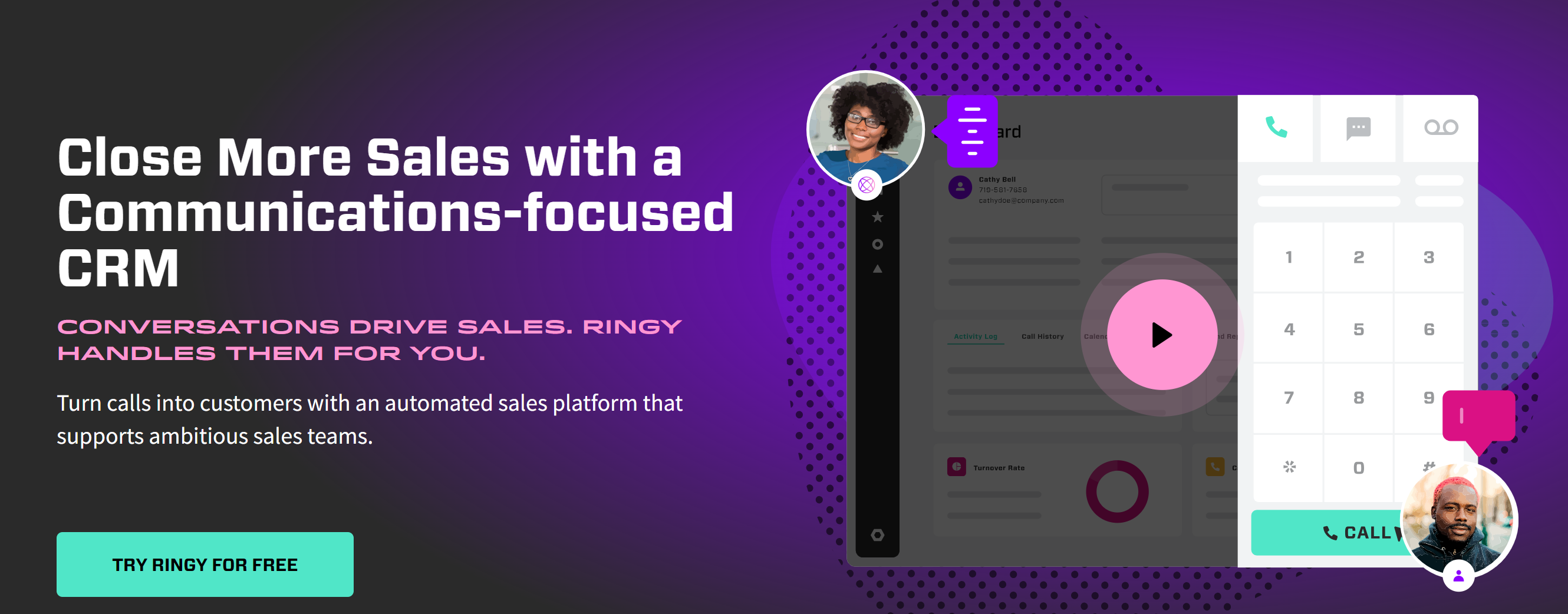
Some all-in-one communications-focused CRM options are expensive, difficult to use, and take a long time to set up. With Ringy, you can not only get going quickly with a comprehensive onboarding plan (that’s included in your subscription, by the way—some platforms make you pay extra for onboarding), you can jump in and start maximizing your sales, marketing, and customer service right away.
Ringy is different because we offer one subscription package—that’s right, one, so no need to navigate different pricing tiers. You can then customize your experience with a-la-carte add-ons like our Power Dialer, Call Scripting Tool, and AI Tools to enhance how you connect and engage with your customers.
Some other standout features that help set Ringy apart from the competition include:
- Unlimited contacts. Many CRM vendors limit the number of contacts you can store in your system based on your subscription tier, especially if they are a cloud-based CRM provider. Ringy doesn’t limit you. So whether you need 100 or 1000 contacts, you’re covered.
- 24/7 customer service. Get help anytime, whether it’s in-person or over online chat. Regardless of your time zone, someone will always be available to walk you through the solution to a problem or help you with your account.
- Easy to use. Forget needing to take hours-long courses just to understand how your CRM works. Ringy has an easy-to-navigate, intuitive interface that means you and your staff can get started integrating your processes into the CRM sooner. Of course, we also offer comprehensive onboarding to help you get started on the right foot.
- Website and mobile app. These days, professionals work from anywhere and often from multiple different devices. You might be on the train and want to check in on a customer’s history before you reach the office or accept an appointment invitation from a new lead. With Ringy, you can do it from your phone via our mobile app (available for Apple and Android) or visit our website to log in.
- Comprehensive integration support. Most businesses use a wide range of different tools in their tech stack as part of their normal operations. Ringy integrates with a variety of popular lead tools, and we also offer API support to ensure that you can create the connections that you need.
Hubspot
The HubSpot marketing automation platform offers a range of AI-powered features and functionalities designed to streamline marketing efforts, enhance customer engagement, and drive results. Here are some key features and functionality of HubSpot from a marketing AI standpoint:
- AI-powered lead scoring: HubSpot's AI-powered lead scoring functionality helps marketers identify and prioritize high-quality leads based on their interactions with your website, emails, and other marketing channels. The AI algorithm analyzes various data points, such as engagement level, demographics, and firmographics, to assign lead scores automatically, allowing sales teams to focus their efforts on the most promising prospects.
- Predictive lead scoring: In addition to traditional lead scoring, HubSpot offers predictive lead scoring capabilities powered by AI. This feature uses machine learning algorithms to predict the likelihood of leads converting into customers based on historical data and behavioral patterns. Predictive lead scoring helps marketers identify hidden opportunities and optimize lead nurturing strategies for better outcomes.
- Content optimization: HubSpot's AI-powered content optimization tool provides actionable insights to improve the performance of your website content, email, and blog posts. The tool analyzes factors such as readability, keyword usage, and SEO best practices to recommend optimizations that can boost search engine rankings and attract more organic traffic. By leveraging AI-driven content optimization, marketers can create more compelling and discoverable content that resonates with their target audience.
- Personalization: HubSpot's AI capabilities and Hubspot CRM email integration enable marketers to deliver personalized experiences across various marketing channels. The platform leverages data-driven insights to segment audiences dynamically and tailor messaging, content, and offers based on individual preferences, behaviors, and lifecycle stages. Personalized marketing campaigns powered by AI help drive engagement, conversions, and customer loyalty by delivering relevant and timely communications to each prospect and customer.
- Automated workflows: HubSpot's workflow automation feature allows marketers to create automated sequences of actions triggered by specific customer behaviors or events. The platform's AI capabilities enhance workflow automation by enabling predictive analytics and dynamic segmentation to deliver more personalized and effective automated campaigns. Marketers can use AI-driven workflows to nurture leads, onboard new customers, re-engage inactive contacts, and more, without manual intervention.
- Reporting and analytics: HubSpot offers robust reporting and analytics capabilities powered by AI to track and measure the performance of marketing campaigns, channels, and content. The platform provides actionable insights and data visualization tools that help marketers understand trends, identify opportunities, and optimize strategies for better results. AI-driven analytics in HubSpot enable marketers to make data-driven decisions, allocate resources effectively, and demonstrate the impact of their marketing efforts on business outcomes.
ActiveCampaign
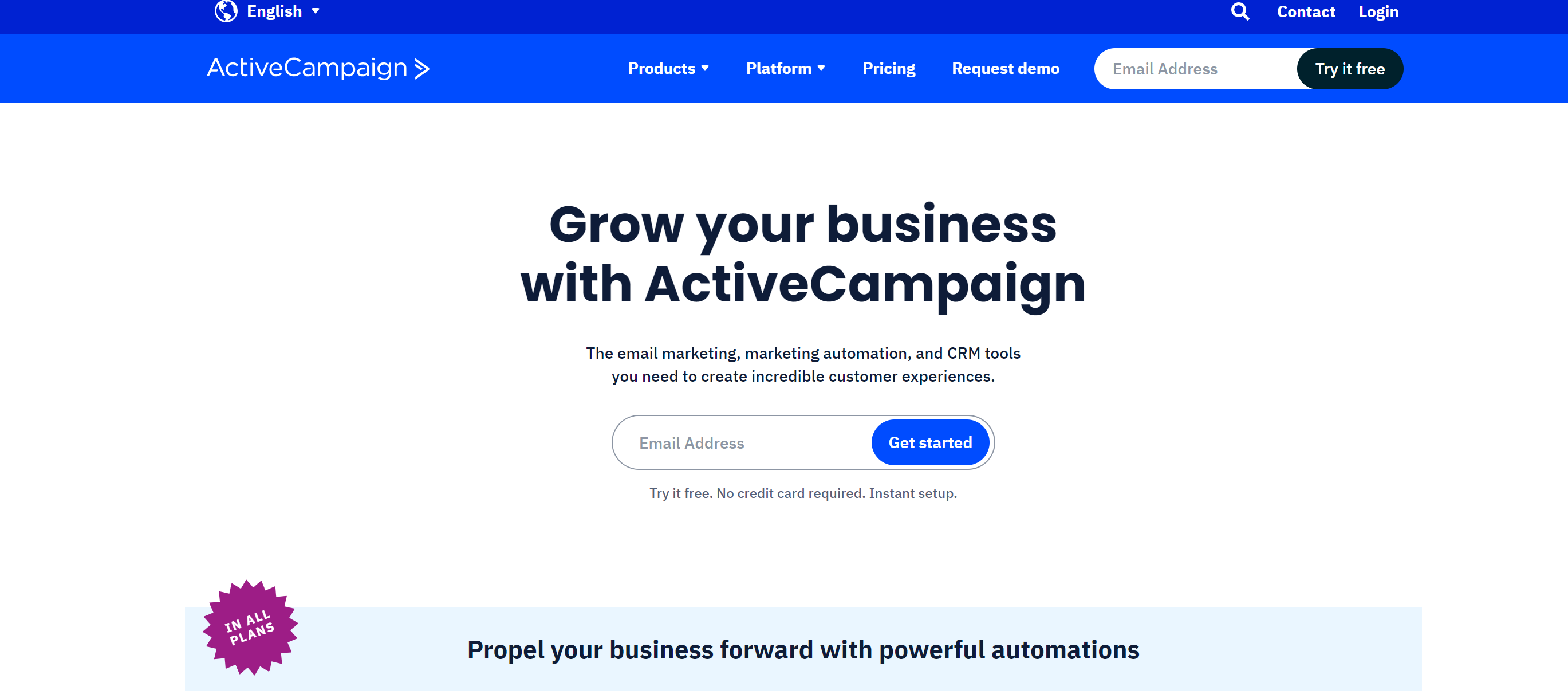
ActiveCampaign is a popular marketing automation platform that offers a variety of AI-powered features and functionalities designed to help businesses automate marketing processes, personalize customer experiences, and drive growth. Here are some key features and functionality of ActiveCampaign from a marketing AI standpoint:
- Predictive sending: ActiveCampaign's predictive sending feature uses AI algorithms to analyze each contact's behavior and engagement patterns to determine the optimal time to send emails. By leveraging predictive sending, marketers can increase email open rates and engagement by delivering messages when contacts are most likely to interact with them.
- Predictive content: ActiveCampaign's predictive content feature enables marketers to deliver personalized content recommendations to contacts based on their interests, preferences, and past interactions. Using AI algorithms, the platform automatically selects and presents relevant content to each contact, increasing engagement and driving conversions.
- Predictive win probability: ActiveCampaign's predictive win probability feature helps sales teams prioritize leads by predicting the likelihood of a lead converting into a customer. By analyzing lead behavior, engagement history, and other data points, the platform assigns a win probability score to each lead, allowing sales teams to focus their efforts on leads with the highest likelihood of conversion.
- Machine learning for segmentation: ActiveCampaign utilizes machine learning algorithms to segment contacts dynamically based on their behaviors, attributes, and engagement patterns. This AI-driven segmentation allows marketers to create highly targeted and personalized campaigns tailored to the unique needs and interests of each segment, resulting in higher engagement and conversions.
- Automated split testing: ActiveCampaign offers automated split testing capabilities powered by AI, allowing marketers to test different variations of email subject lines, content, and calls-to-action to determine the most effective messaging. The platform automatically analyzes the performance of each variation and selects the winning version, enabling marketers to optimize campaign performance and drive better results.
- Event and behavior tracking: ActiveCampaign's AI-powered event and behavior tracking capabilities enable marketers to track and analyze customer interactions across multiple touchpoints in real-time. By capturing and analyzing behavioral data, marketers gain valuable insights into customer preferences, interests, and intent, allowing them to deliver more relevant and timely communications.
- Predictive analytics: ActiveCampaign provides predictive analytics features that leverage AI algorithms to forecast future trends, identify opportunities, and anticipate customer needs. By analyzing historical data and patterns, the platform helps marketers make data-driven decisions and optimize marketing strategies for better outcomes.
Conclusion
Marketing automation is a powerful tool for businesses looking to maximize ROI and drive results in today's competitive landscape. By automating repetitive tasks, streamlining processes, and delivering personalized experiences, businesses can better engage with their audience, nurture leads, and ultimately drive conversions. From email marketing and lead management to social media marketing and advertising, marketing automation offers a range of functionalities tailored to meet the unique needs and objectives of different industries.
With the integration of AI and machine learning technologies, marketing automation platforms are becoming increasingly sophisticated, enabling businesses to leverage data-driven insights and predictive analytics to optimize their marketing strategies and achieve better outcomes. However, it's important for businesses to approach marketing automation thoughtfully, balancing the digital with the human element to ensure a seamless and personalized customer experience. By harnessing the power of marketing automation effectively, businesses can stay ahead of the curve and drive growth in today's digital age.
Take your sales to new heights with Ringy.
Book A Demo
